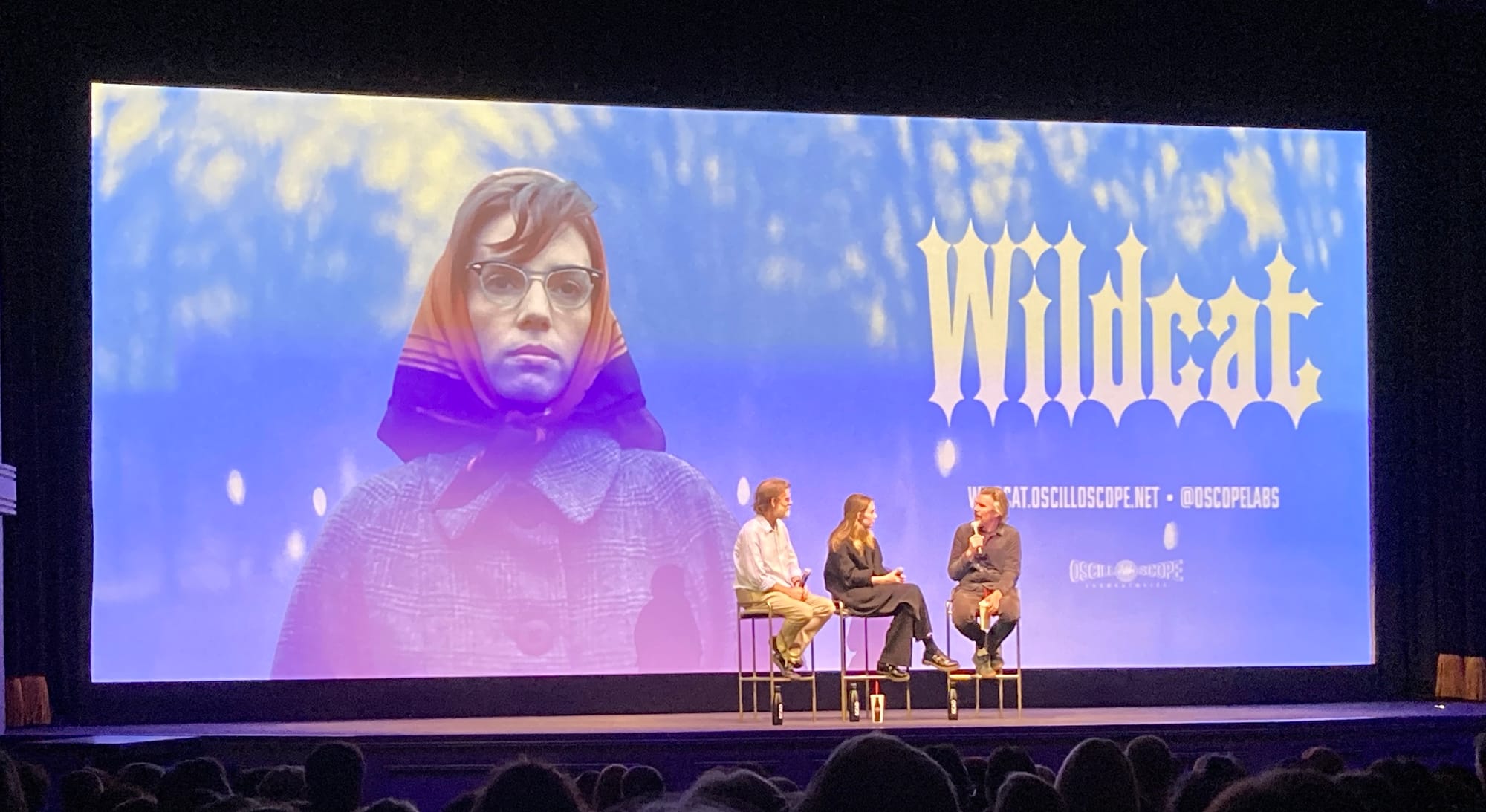ETHAN HAWKE and daughter Maya Hawke debuted their collaborative film Wildcat – a challenging but deeply satisfying revery about the key years of Flannery O’Connor’s life – to a sold-out crowd at the Trustees Theatre last night.
Maya Hawke, whose gripping and passionate portrayal of O’Connor would in a more just world be an instant Oscar nomination, said the movie is neither biopic nor documentary, but more of a tone poem about the “impact that Flannery O’Connor has had on our lives.”
Wildcat combines some of my favorite things in cinema, and combines them perfectly: Nonlinear storytelling, ensemble casting, a refusal to patronize viewers, and a moral ambiguity that invites audience introspection.
While the “regular” parts of the film portray O’Connor’s inner struggles to define her life as a devoutly Catholic writer while also dealing with the diagnosis of lupus that would eventually kill her, that narrative is cinematically interspersed with taut, viscerally imagined vignettes taken from various O’Connor short stories and novels.
Maya portrays a lead character in all these vignettes as well, joined by the truly amazing Laura Linney, who also portrays Flannery’s mother Regina in the standard narrative parts of the film.
It’s rare to see this kind of creative, actorly stretching in a mainline movie anymore. Almost more of an artifact of theatrical stage work, these multiple roles performed by the same actors also invite the audience to see parallels between the vignettes and O’Connor’s real life – particularly her troubled relationship with her mother and chief caregiver.
If it sounds corny, it’s anything but. And it’s this highly creative approach that, while perhaps a bit too challenging for some modern audiences, makes Wildcat a true work of cinematic art.
“We didn’t want these to feel like skits,” Maya said during the post-screening Q&A. “They are parts of Flannery’s world, and we’re trying to show her creative process…. Laura and I really tried to hold on to the bits of Flannery and Regina that we had created, and we then – rather than Maya and Laura in a skit – imagined Flannery and Regina in a dream.”
Ethan Hawke, who directed and co-wrote the film, echoed his daughter.
“For me, the movie is a fever dream,” said Ethan. “Each story unlocks the emotional journey. The literal journey of the film is Flannery finding out she’s diagnosed with lupus. She feels it’s a death sentence. Her father died of lupus. And how she’s desperate to get out of Milledgeville, Georgia. And now she’s trapped there… The movie to me is, what’s the journey that brings you to the inner transformative place where you go, I not only accept this, but I embrace it.”
However, for most viewers, the key scene in the film is neither an imaginatively recreated excerpt nor a mother/daughter interaction. It’s a tense but transcendent two-person scene with Maya Hawke and Liam Neeson, as the parish priest who visits her bedside in Milledgeville.
If there’s an Oscar-clinching scene in the film, it’s this one. Confined to bed, Maya plumbs the depths of O’Connor’s passion – in the true sense of the word meaning “suffering” – for knowing Christ, for gaining grace, for realizing her calling and charity in life, and facing her inevitable early demise from hereditary illness.
Did I say Christ? Yep, sure did. Probably the most courageous aspect of Wildcat is how, almost alone among modern films, it portrays religiosity and faith not as a trope or as an object of parody and derision, but as a real thing in people’s lives, a driving force that motivates them to not only do good works but to realize themselves.
While none of the message attempts to convert anyone – it can be appreciated by anyone of any religion, or none at all – Wildcat deals frankly with O’Connor’s very specific and inner-focused Roman Catholic perspective of faith, life, and mysticism.
Maya Hawke said O’Connor’s posthumously published religious diary, A Prayer Journal – which is exactly what the title says it is – played a major role in this decision.
“My dad and I read A Prayer Journal together and we started developing this monologue based on her Prayer Journal. In the scene with Liam Neeson you just watched, that’s very similar to the first monologue we developed, that was kind of extracted from the Prayer Journal.”
As someone who grew up seeing my fellow Savannah native increasingly portrayed as a “quirky” cartoon character or postmodern feminist icon, it was refreshing to see a film that didn’t dampen the intensity of O’Connor’s religiosity with the blanket of 21st century secularism.
It was also a very wise choice for Ethan and Maya Hawke to directly confront, as best they could, the most problematic aspect of Flannery O’Connor, who was after all a product of the segregated South. Which, simply put, is the unalloyed fact that she would be considered racist by any modern standard.
"Any time you tell a story about an American you end up telling America’s story,” Ethan told the audience. “And America is full of wounds and sins and crimes that are very difficult to talk about.”
Ethan told how his mother gave him some O’Connor writings “as a proud feminist. She thought they were anti-racist, because the racists in the stories are always getting gored by bulls or hit. I think in a lot of Flannery’s work, she’s driving there. It was very hard when we started working on this and I started discovering some of the more vile and reprehensible things she said in her letters. It was really upsetting. So Maya and I said, ‘do we not make this movie?’”
In the end, Ethan said he and Maya decided that “the reason not to make the movie was because we were scared to have this conversation with you… but we’re not scared to have it. This country is a racist country. And Flannery O’Connor, like the country that fed and raised her, is a recovering racist.”
The only possibly "negative" thing about the film for a Savannah audience is that none of it was filmed anywhere near O'Connor's birthplace here nor in Milledgeville, where she did all her important writing.
Instead, Wildcat was filmed in Kentucky. That said, the setting convincingly portrays both the built and natural environment of Andalusia, the family home on the outskirts of Milledgeville that you can tour.
Ethan joked that he would have preferred filming in Georgia, but "Marvel took over all the studios here.... along with Stranger Things," a cheeky nod to the franchise that brought his daughter to widespread fame and acclaim as an actress.

